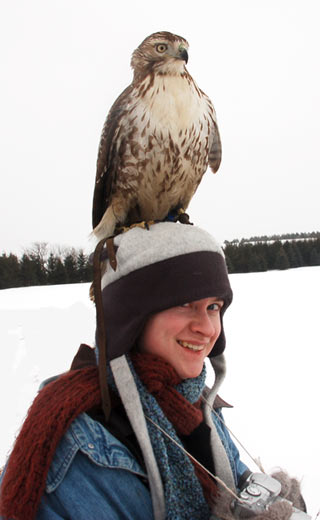Raptor Adventures - January Pt. 1

Beginning my adventure into falconry, I was very lucky to meet Carolyn, a local falconer who is flying a red-tailed hawk this season. She invited me to come hunting with her to get a bit more exposure to falconry in practice. It was a fantastic experience!

Meet Bailey!
So, in Minnesota you have a choice between two birds as your apprentice birds - a kestrel or a red-tailed hawk. I have been researching and coming to appreciate red-tails more and more over the last year, and plan to choose one when I am ready for a bird of my own.

This is Carolyn - she trapped Bailey last September and he's already flying like a pro. It's amazing how fast these hawks adjust to people (being totally wild birds) and figure out it's in their benefit to stick by us.

You're not going to catch anything down there, Bailey!

I was a bit put off at the beginning with the idea of having to trap a wild bird as a first step - coming from my experience with parrots and corvids, I can't imagine getting a wild caught one as a beginner and fumbling my way through it - it seems completely counter intuitive. However, raptors are a whole other ball game and the usual rules don't apply. Falconry can actually benefit wild birds (one reason it is still allowed with such strict restrictions on keeping of native birds) - there is a 70-80% mortality rate among first year red-tails. If you think about it, these birds are set off into an unforgiving world with so much to learn (and a fast metabolism + cold winters that doesn't allow for any mistakes). With a falconry bird, that young bird gets an extra year (or a few) of guaranteed food, shelter, and care. Also, the bird gets a chance to practice flight, hunting skills, and learning to use its feet correctly. When the bird is eventually released, it goes back to a wild state very readily, with a bit better chances at surviving in the long run.

Falconry also has an awesome system for permitting. It's really a model for the exotic/wild animal industry as a whole - I wish all exotics required something similar (instead of just being allowed or outright banned). For instance, if wolves and wolf-dogs required a similar permit I think it would stop a massive amount of the problems we have with them today.

Basically, you have to find a mentor - someone who is licensed at general or master level to guide you. You take a test, get your facilities inspected, pay a fee, and then you are able to trap your first bird. Your mentor works with you for a minimum of two years, guiding you through the process and showing you the ropes. After that you can get promoted to general rank, and after five years of that (minimum), to master rank. There is a great community of people sharing information and benefiting the care of the birds. Of course things aren't perfect, and some people get birds for the wrong reasons - but overall the system is amazingly well run.

Vantid sporting Bailey as a hawk hat.

Bailey sitting atop my storage shed.

One of the best things about falconry (after being around these amazing birds doing what they do best - flying and hunting) is just being outside, tromping through the snow and enjoying nature. Even though I live in the suburbs, there is wildlife here - this was a fox we saw while we were out, scampering about in the fields behind my home.

Bailey coming down to the lure after the hunt.
For my first experience out with a hunting hawk, it was a blast and left me wanting more. I've gone out a few more times since and the birds have me... hook, line, and sinker. :)